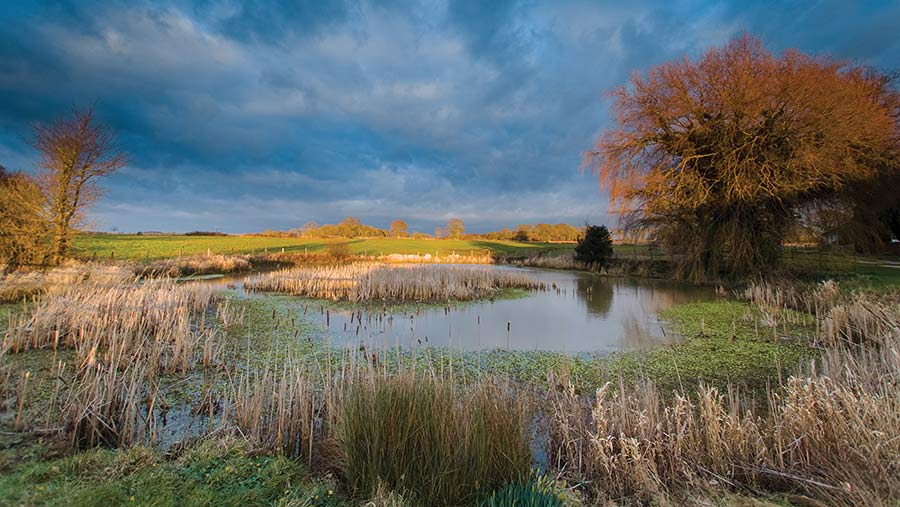Tax consultation response calls for natural capital payment changes
 © Trevor Woodville/Adobe Stock
© Trevor Woodville/Adobe Stock Farm and rural leaders have set out their thoughts on how to tackle the inheritance tax risks which are acting as an obstacle to farmers entering more land into environmental commitments.
A consultation was announced in the Spring Budget on whether agricultural property relief (APR) from inheritance tax (IHT) should be extended to land being used for environmental purposes, to ensure that farmers and landowners are not deterred from making such changes of land use.
See also: Advice on long-term land agreements as new markets develop
There was also a call for evidence on the tax treatment of the production and sale of ecosystem service units, such as woodland carbon, biodiversity net gain and nutrient mitigation credits.
One of the central questions posed by the consultation is whether the scope of APR needs to change, because of concern that once land is taken out of agricultural production and given over to environmental delivery it will no longer qualify for the relief.
Without APR, there is the risk of affected land and property being subject to a 40% IHT charge.
Depending on the proportion of land which is taken out of agricultural use, APR may also no longer be available on the farmhouse and buildings.
In its response, the NFU calls on the government to spell out which, if any, of the options offered in its Environmental Land Management (ELM) schemes might result in land no longer being classed for agricultural use.
Previous agri-environment schemes have rarely resulted in land ceasing to be classed as agricultural, and HMRC had already recognised that land entered into the Sustainable Farming Incentive (SFI) would remain in agricultural production, it points out.
Widespread uncertainty
“However, by not going on to set out which of the options within Countryside Stewardship or Landscape Recovery this would also be true of, when it could be the case for the majority, leaves further widespread uncertainty,” says the union.
It argues that a simple approach could be to legislate so that any land entered into any aspect of ELM, or equivalent schemes in the devolved nations, will be treated as remaining within agricultural use.
If land was not within ELM or an equivalent scheme, but being used for environmental commitments and therefore not agricultural, Business Property Relief (BPR) might apply to that use or should be available if it was the smaller part of a wider agricultural business, it maintains.
Food security risk
However, at this stage the union says it is against widening APR beyond ELM to cover cases where land was being taken completely out of agricultural production and becoming a passive investment, because of food security concerns.
“Providing APR to private investors with no ongoing link to agriculture or trading activity may encourage the buying up of farmland and it being taken completely out of production, with no regard to the wider impact,” it says in its response to the consultation.
“This could undermine the competitive position of our members’ businesses in acquiring land for productive use, such as food production, and also risk undermining their productive capacity and UK food security.”
TFA calls for safeguards
The Tenant Farmers’ Association agrees with the NFU that any changes to the taxation regime need safeguards to avoid significant loss of land from food production.
It favours a land sharing approach, involving amending the definition of agriculture to include environmental services, so long as they are being implemented alongside traditional agricultural activities.
It would not be in the public interest for land to be granted access to APR where it had been diverted from agriculture into exclusively environmental use, but did not form part of a wider business unit meeting the definition of agriculture, it says.
The TFA also points out that APR would only be available to a landlord if the tenant is carrying on agricultural activities, so landlords are often resistant to the tenant moving land out of agricultural use into more environmental uses.
“A simple solution here would be to allow all let land either under the Agricultural Holdings Act 1986 or Agricultural Tenancies Act 1995 to be eligible for APR subject to its rules of application,” says the TFA in its response to the consultation
“Making this change would remove the need for landlords to be cautious about allowing their tenants to be involved in environmental markets for fear of changing their taxation status as a result.”

© Marcin Rogozinksi/Adobe Stock
Market distortion
The Central Association for Agricultural Valuers (CAAV) says the extension of APR to cover land used for environmental commitments would give a very powerful signal to farmers that they could consider changing land use without penalty.
It warns in its response that the idea of offering APR only on environmental land that was part of a specified scheme such as ELM risks distorting the market, as there are already many such schemes and new ones are being developed all the time.
For example, it would be problematic if land in a Countryside Stewardship option qualified, but land in a 125-year nutrient neutrality agreement did not, it maintains.
“Equal commitments should have equal treatment,” says the CAAV. “Habitat commitments under a biodiversity net gain agreement, a conservation covenant, a commitment with a water company or a local authority scheme should have equal ranking with the same habitat creation commitment under Defra’s enhanced Countryside Stewardship and Landscape Recovery schemes.”
The Country Land and Business Association (CLA) says while the consultation proposes to limit the relief only to land that was previously in agricultural use, it would like it offered to all land used for environmental land management and ecosystem services.
It says there also needs to be consideration of how environmental land uses interact with BPR.
Trading or investment?
Many farms have already diversified, points out the CLA, and to qualify for BPR they need to ensure that their business as a whole is not too weighted towards investment activity, or they could fail the Balfour test.
The Balfour case discussed the tests established in the Farmer case, which are the tests applied by HMRC when assessing a diversified estate or farm’s claim for BPR.
It concluded that the relief should be available where a business is judged to be predominantly a trading rather than mainly an investment business, as long as certain conditions are met.
“It is at present not clear whether all forms of environmental land management will be regarded as trading activity, which therefore means that there is a risk to farm owners that converting part of their land from agriculture to such use could cause the business to become mainly investment,” says the CLA.
“The result of this would be to lose BPR on the whole business, not just the land being converted to environmental land management use.”
Key questions and issues
- Lack of clarity on tax treatment of sale of ecosystem service units such as carbon credits – should they be taxed as income or a capital gain?
- Should large upfront payments for long-term environmental land uses be treated as a capital receipt or income?
- What type of environmental commitments should qualify for APR – should it be only schemes such as ELM, or should it also apply to farmers selling ecosystem services in private markets?
- How should environmental commitments interact with BPR – the trading or investment question
- Will restricting APR to tenancies of at least eight or more years help or harm the tenanted sector?
Ecosystem services payments – tax issues

© Julian Gazzard/Adobe Stock
On the topic of how payments for ecosystem services should be treated, respondents agree that HMRC should convene a roundtable to look at common situations and decide which accounting and tax principles could then be applied.
A similar approach was taken to produce HMRC guidance when the Single Payment Scheme was introduced.
Chartered accountant PKF Francis Clark also responded to the consultation and says principles need to be agreed which confirm whether receipts from selling ecosystem services would be charged to income tax or capital gains tax (CGT); whether the activity was deemed to be trading; and how income and expenses should be matched over the period of a contract.
For example, there is an argument that receipts from any land entered into a conservation covenant should be treated as capital on the basis that the covenant would restrict the future use of the land and so devalue it.
HMRC’s guidance on capital sums derived from assets also points to the receipts being chargeable to CGT.
However, any management fee received in return for providing the service of creating and maintaining habitat would be subject to income or corporation tax.
Another area of debate is how to treat the costs associated with maintaining habitats. PKF Francis Clark poses the questions:
- Are the costs capital, enabling the creation of a new income stream? If so, can rollover relief be applied?
- Does the enhancement expenditure add to the base costs of the land and therefore any tax relief is only obtained when the land is sold?
- Alternatively, are the costs deductible as income, being the costs to provide the service in respect of the management fee?
The firm also highlights that income arising from the commercial occupation of woodland sits outside the scope of income and corporation tax.
However there is uncertainty as to whether planting woodland to generate income from the sale of carbon units or Pending Issuance Units (PIUs) falls within the existing tax exemption. A PIU is a promise to deliver a woodland carbon unit in future, based on predicted sequestration.
The VAT treatment of ecosystem services payments (ESPs) is another area where clarity is needed, it says. “Aligning the treatment with other farming receipts, at zero rate, seems to be the most sensible approach.”
The CLA argues that if ESPs are not seen as farming trade income, farmers may struggle to set farming losses against environmental income. They should be allowed to elect for their business to be treated as a single business unit, says the association.
This would also reduce the administrative burden associated with the introduction of Making Tax Digital for income tax, which will require quarterly updates of income tax and expenses to HMRC.
“If ecosystem service payments income is not classed as farming income, a diversified business with farming income and income from ecosystem services, a furnished holiday let and a residential let will have to submit 16 quarterly returns, four end-of-period statements and a final declaration each tax year.”
